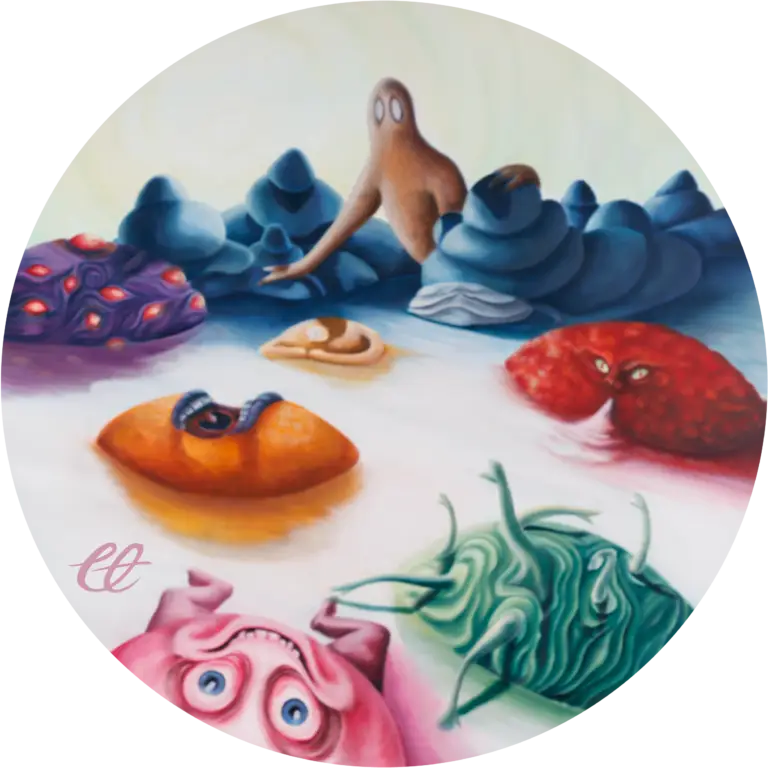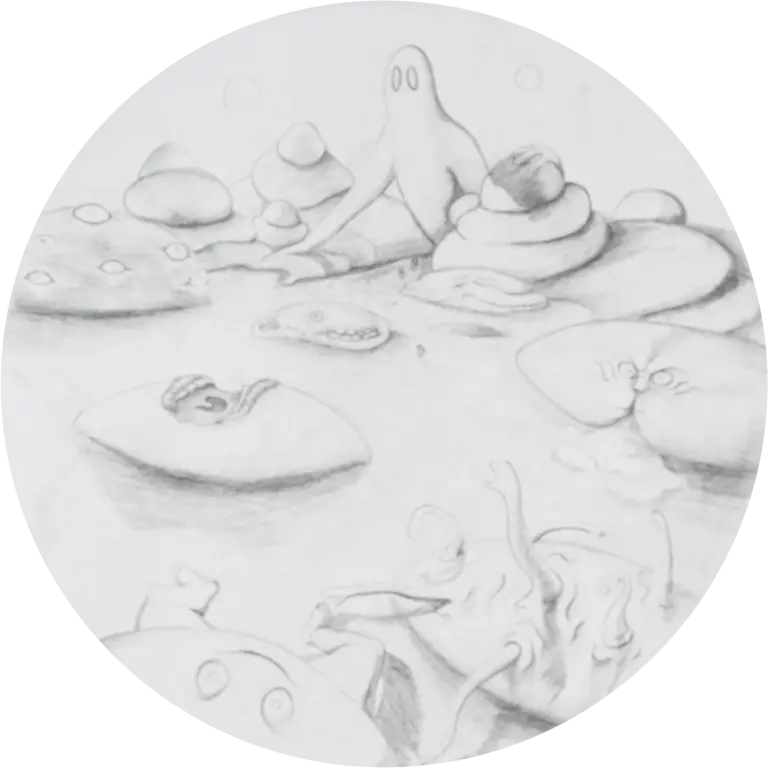

Seven Deadly Sins
Oil painting on a wood panel measuring 36″
By Corrine Anderson
“Led by the ambitious god ‘Self’, the ‘Manz’ will soon discover a source of power. Sins of all colors will adhere their characteristics to ‘Manzkind’. By receiving these faults, ‘Manzkind’ will create a dystopian society. Growing selfishly and ironically, using the massive potential they have for the individual rather than the whole.“
This post explores ‘Seven Deadly Sins‘, the second piece in my ‘Fall Down‘ series. If you love this piece, I offer high-quality canvas prints in my shop. Thank you for your support!
Fall Down, Part two
As I was still working on the painting for the previous piece, I began conceptualizing the next drawing. This approach helped me stay on track and maintain consistency in the narrative. It also prevented me from getting too caught up in each individual painting and reminded me that the story had to move forward. Plus, it can get monotonous to work on the same piece for too long—new ideas are always exciting. I have to say, this was one of my favorite concepts to draw, especially when it came to creature creation.
The idea of the Seven Deadly Sins has always been a major source of inspiration for me. The darker side of human psychology has intrigued me since childhood, and I first encountered the Seven Deadly Sins in high school. The visual embodiment of evil has played a significant role in shaping much of my early work as an emerging artist. So, when it came time to create this piece, I was particularly excited. This painting represents why we are the way we are as individuals. I believe every person struggles with at least one of the deadly sins. Wrath, gluttony, envy, lust, greed, pride, and sloth exist within all of us. In truth, it is often our faults that become our downfall. These sins can ruin relationships, damage our self-esteem, disrupt our sense of self, and hinder our productivity. Therefore, I made them a central theme in this series.
When the firstborn Manz released the Seven Deadly Sins into the world, they also unleashed a dangerous god: Self, representing the ego of humankind. As the firstborn Manz prioritized their own desires over better judgment, Self was born, allowing the Seven Deadly Sins to take root in the landscape. Self leads the Manz into an ominous garden, where each Manz is drawn to the sin they most relate to. Self explains that each sin holds great power, and this is true in our world as well. Every characteristic—positive or negative—can be used for good or evil. Though these sins are typically seen as negative, they aren’t inherently evil. It’s how much control we give them that makes them dangerous. Wrath can fuel passion, envy can inspire motivation, pride can build confidence, sloth can encourage reflection, lust can lead to love, greed can drive ambition, and gluttony can bring comfort. However, when these traits are used for selfish or malicious purposes, they inevitably lead to destruction.
With great power comes great responsibility, and if there’s one thing humankind lacks, it’s responsibility and accountability. The Manz, too, have neither.
Moving from left to right, I’ll explain the depiction of each sin. Pride, in the top left, is purple, with prying red eyes constantly watching the others, fearful of being made a fool. Greed, to the right, is yellow, representing gold. It hoards its treasures with unyielding arms, its wide eye perpetually scanning the surroundings, never willing to part with its possessions and always looking for more. Sloth, a gray mass to the right of Greed, is stagnant and unmoving, practically collapsing into itself. Its folds sink deeper into the ground, drawing only enough energy to sustain its existence. Wrath is portrayed as a large red fiery mass with angry, hateful eyes. It constantly exhales, causing the ground beneath it to burn with intense heat. Wrath cannot contain its rage, subjecting everything around it to searing pain.
Gluttony, an orange mass with a wide purple mouth gaping at its top, constantly consumes, but is never satisfied. It remains in a state of hunger, always open, always craving more. Envy, to the right, is a green, wrinkled mass without a clear identity. Its hands reach out aimlessly, desperately seeking something to reflect. Lonely and perpetually yearning for acceptance, Envy is trapped in a constant state of longing, its traits isolating it further from others. Lust, positioned in the foreground, makes direct eye contact with the viewer, creating a sense of intimidation. Lust gazes at the viewer, desperately craving meaningful relationships but unable to maintain them due to the overwhelming intensity of its desires.
The story unfolds in this piece, set in a garden behind the birthplace of the Manz. The next step in their development, as with humanity, is the process of self-discovery. In the series, this evolution is accelerated and condensed into a more intense and immediate journey. As time progresses in the story, it also does so in the painting. The sun has risen high in the sky, signaling that it is now afternoon. The light is blinding, and the cloud cover has disappeared, casting a sense of brilliance but also forewarning of impending doom. The peacefulness of the world is slipping away, and the future that Prosper had warned them about is now coming to fruition. By following Self, the Manz have chosen their own desires above all else—above the creatures of their world and nature itself. Only destruction can result from such a choice.
Self is depicted as a faceless, ghost-like being, lacking any features because, like the ego itself, Self is unidentifiable and unique to each individual. The ego is faceless, and it takes on different forms for every person.
One element I wanted in this painting was a large number of Manz running toward each sin, but again, time was of the essence, and I had to move on to the next piece. So, onto the next!
Thank you for reading part two of my six-part series, Fall Down! I’m thrilled to share this journey with you, and I hope you’re as excited as I am to see what happens next. Don’t miss out—sign up for my newsletter to stay updated on new content and be the first to know when part three is released!
Fall Down, Part two
As I was still working on the painting for the previous piece, I began conceptualizing the next drawing. This approach helped me stay on track and maintain consistency in the narrative. It also prevented me from getting too caught up in each individual painting and reminded me that the story had to move forward. Plus, it can get monotonous to work on the same piece for too long—new ideas are always exciting. I have to say, this was one of my favorite concepts to draw, especially when it came to creature creation.
The idea of the Seven Deadly Sins has always been a major source of inspiration for me. The darker side of human psychology has intrigued me since childhood, and I first encountered the Seven Deadly Sins in high school. The visual embodiment of evil has played a significant role in shaping much of my early work as an emerging artist. So, when it came time to create this piece, I was particularly excited. This painting represents why we are the way we are as individuals. I believe every person struggles with at least one of the deadly sins. Wrath, gluttony, envy, lust, greed, pride, and sloth exist within all of us. In truth, it is often our faults that become our downfall. These sins can ruin relationships, damage our self-esteem, disrupt our sense of self, and hinder our productivity. Therefore, I made them a central theme in this series.
When the firstborn Manz released the Seven Deadly Sins into the world, they also unleashed a dangerous god: Self, representing the ego of humankind. As the firstborn Manz prioritized their own desires over better judgment, Self was born, allowing the Seven Deadly Sins to take root in the landscape. Self leads the Manz into an ominous garden, where each Manz is drawn to the sin they most relate to. Self explains that each sin holds great power, and this is true in our world as well. Every characteristic—positive or negative—can be used for good or evil. Though these sins are typically seen as negative, they aren’t inherently evil. It’s how much control we give them that makes them dangerous. Wrath can fuel passion, envy can inspire motivation, pride can build confidence, sloth can encourage reflection, lust can lead to love, greed can drive ambition, and gluttony can bring comfort. However, when these traits are used for selfish or malicious purposes, they inevitably lead to destruction.
With great power comes great responsibility, and if there’s one thing humankind lacks, it’s responsibility and accountability. The Manz, too, have neither.
Moving from left to right, I’ll explain the depiction of each sin. Pride, in the top left, is purple, with prying red eyes constantly watching the others, fearful of being made a fool. Greed, to the right, is yellow, representing gold. It hoards its treasures with unyielding arms, its wide eye perpetually scanning the surroundings, never willing to part with its possessions and always looking for more. Sloth, a gray mass to the right of Greed, is stagnant and unmoving, practically collapsing into itself. Its folds sink deeper into the ground, drawing only enough energy to sustain its existence. Wrath is portrayed as a large red fiery mass with angry, hateful eyes. It constantly exhales, causing the ground beneath it to burn with intense heat. Wrath cannot contain its rage, subjecting everything around it to searing pain.
Gluttony, an orange mass with a wide purple mouth gaping at its top, constantly consumes, but is never satisfied. It remains in a state of hunger, always open, always craving more. Envy, to the right, is a green, wrinkled mass without a clear identity. Its hands reach out aimlessly, desperately seeking something to reflect. Lonely and perpetually yearning for acceptance, Envy is trapped in a constant state of longing, its traits isolating it further from others. Lust, positioned in the foreground, makes direct eye contact with the viewer, creating a sense of intimidation. Lust gazes at the viewer, desperately craving meaningful relationships but unable to maintain them due to the overwhelming intensity of its desires.
The story unfolds in this piece, set in a garden behind the birthplace of the Manz. The next step in their development, as with humanity, is the process of self-discovery. In the series, this evolution is accelerated and condensed into a more intense and immediate journey. As time progresses in the story, it also does so in the painting. The sun has risen high in the sky, signaling that it is now afternoon. The light is blinding, and the cloud cover has disappeared, casting a sense of brilliance but also forewarning of impending doom. The peacefulness of the world is slipping away, and the future that Prosper had warned them about is now coming to fruition. By following Self, the Manz have chosen their own desires above all else—above the creatures of their world and nature itself. Only destruction can result from such a choice.
Self is depicted as a faceless, ghost-like being, lacking any features because, like the ego itself, Self is unidentifiable and unique to each individual. The ego is faceless, and it takes on different forms for every person.
One element I wanted in this painting was a large number of Manz running toward each sin, but again, time was of the essence, and I had to move on to the next piece. So, onto the next!
Thank you for reading part two of my six-part series, Fall Down! I’m thrilled to share this journey with you, and I hope you’re as excited as I am to see what happens next. Don’t miss out—sign up for my newsletter to stay updated on new content and be the first to know when part three is released!
Canvas prints
Buzzin’ Here Mouse pad
$15.00
Early Bird Unisex Tee
$30.00
Early Bird Mouse Pad
$15.00
Early Bird Crop Hoodie
$50.00 – $52.00Price range: $50.00 through $52.00
Early Bird Micro Tank
$35.00
Early Bird Mug
$15.00
